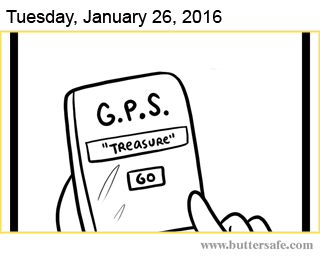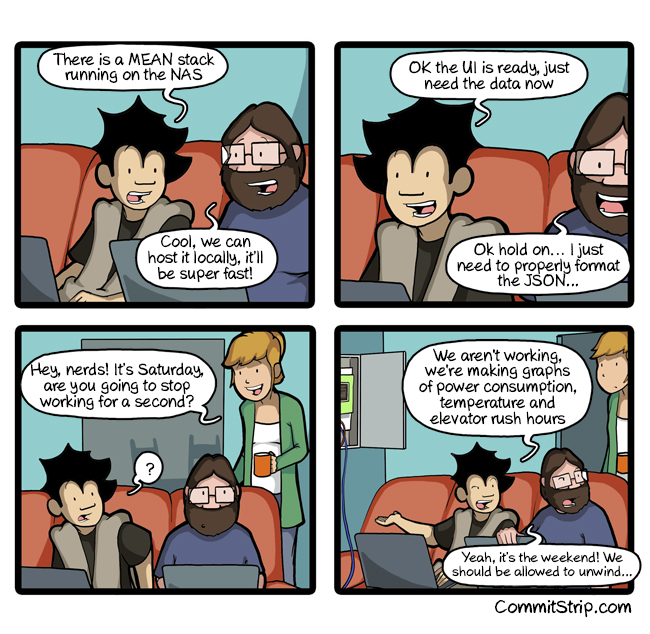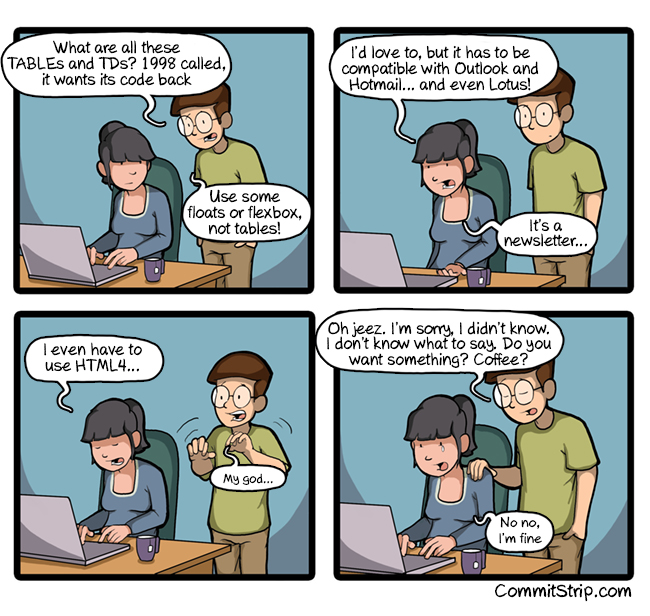
Dan Jones
Shared posts
Drop Stop - Car Seat Gap Filler
Dan JonesGenius!

Sometimes crack kills. Other times it sucks your phone, coins, parking validations, and Boom Chicka Popcorn into the black hole that is the space underneath your seat. At best, it forces blind digging and awkward arm contortions. At worst, it holds a chunk of your kid's chicken nugget hostage indefinitely, letting nothing escape but the aroma of rotting bird. Shark Tankers Marc Newburger and Jeffrey Simon conquer what they call this "Carmuda Triangle" with the Drop Stop, a universal car seat gap filler.
Drop Stops, sold in sets of 2, have built-in slots that attach to the seatbelt catch and create a solid plane between the door and the edge of the cushion. The fillers are made of high-grade neoprene with expansion / contraction properties to enable them to fit most vehicles and gap sizes currently sucking up your belongings. Once in place, Drop Stops should require no readjustment or reinstallation, even when you need to move your seat.
20 Years Ago Today, Sun Almost Bought Apple for $4 Billion
Business Insider:
On January 26th, 1996, exactly 20 years ago to this day, early tech blog Suck.com reported that Sun Microsystems was in talks to buy up Apple, then worth $3.89 billion.
“Back in late 1995 early ‘96, when we were at our peak, we were literally hours away from buying Apple for about $5 to $6 a share,” former Sun President Ed Zander would later recall in 2011.
Today, Sun is out of business and Apple is the most profitable company in the world. Not sure where Michael Spindler is.
Lindsey Stirling’s Memoir Makes New York Times’ Best Seller List
New York Times ranked Lindsey Stirling’s new book, “The Only Pirate at the Party,” number 10 on the hardcover nonfiction best seller list.
Legend of Zelda Paintings Inspired by Classic Masterpieces
Legend of Zelda Paintings Inspired by Classic Masterpieces
Illustrator / Painter ?stor Alexander was inspired by classical masterpieces, and replaced the original protagonists with characters from The Legend of Zelda video games. The results are stunning! The first painting is called "The Beast and The Princess", inspired by "The Death and the Maiden" by Pierre-Eug?ne-Emile H?bert (19th Century French sculptor) and the second is called "Hero of Time", inspired by "David with the Head of Goliath" by Caravaggio (17th century baroque Italian painter). Here is the new fan art, the originals which inspired it and close-ups details...










Artist: ?stor Alexander
Inspired by: "The Death and the Maiden" by Pierre-Eug?ne-Emile H?bert & "David with the Head of Goliath" by Caravaggio
(via: Geek Art)
Follow us on:
January 26 2016
Introducing the Security Panel in DevTools
- Certificate verification, indicating whether your site has proven its identity with a TLS certificate.
- TLS connection, indicating whether your site uses a modern, secure protocol and ciphersuite.
- Subresource security, indicating whether your site loads insecure HTTP subresources (otherwise known as mixed content).
Posted by Emily Stark, Green Lock Whisperer and Lucas Garron, Mixed Content Warrior
Church Releases Map of All 150 Operating Temples Around the World
On March 20, days before the 180th anniversary of the dedication of that first temple since the Restoration of the gospel, Church members will again gather to celebrate another dedicated house of the Lord—the Provo City Center Temple—as it becomes the Church’s 150th operating temple.
Spotify will launch video content on Android this week
A while back, Spotify announced that it was working to add video content into its mobile app. The service, which revolves primarily around streaming music, has been looking for additional ways to cater to users. Video is one way in which the company can pull in new users and encourage existing users to spend more time within Spotify.
Spotify’s video offerings will consist of content from partners such as ESPN, Comedy Central, Vice Media, Maker Studios, Tastemade and BBC. Notably, the content is coming from providers within both traditional and digital media. Much of Spotify’s video content will consist of short clips, such as sports game highlights or comedy sketches. During its testing, Spotify found that packaging related video content improved the effectiveness. Expect to see video packages, with some examples being “Laughs at Lunch” and “News of the Week”. 
At this point in time, the video content will be ad-free, even with Spotify paying to license the content from its partners. In the future, however, the company may look into advertising within video content as a potential means to create profit.
Spotify’s video content will be rolling out in the Android app later this week, with iOS users seeing the new feature by the end of next week. To begin, video content will be available in the US, UK, Germany and Sweden.
Check out The Wall Street Journal‘s article to hear more.
Google Play Free Song of the Day 1/25/2016
Piece By Piece (Google Play Deluxe Edition) (Entire Album)
By
Kelly Clarkson
About the artist

ADDITIONAL INFORMATION
Digital Copies of LDS Patriarchal Blessings
 Did you know that you can request an electronic copy of your patriarchal blessing that you can view online or download to your computer or smart phone?
Did you know that you can request an electronic copy of your patriarchal blessing that you can view online or download to your computer or smart phone?
You can also get copies of blessings for deceased direct-line ancestors, deceased children, or a deceased spouse by mail.
Patriarchal blessings are given to worthy members of the Church by ordained patriarchs. Learn more about patriarchal blessings in the Gospel Topics section of LDS.org (topics.lds.org).
Two new online tools have been created to help submit gather, preserve, and share patriarchal blessings.
- A new online submission tool helps leaders create patriarchal blessing recommends and submit the official blessings to the Church.
- An online request tool allows members to request a digital copy of their own blessing and then view the copy online.
To request a digital copy of your blessing, go to LDS.org, click My Account and Ward in the upper right corner, then select Patriarchal Blessing.
Learn more on the Patriarchal Blessings information page.
Here Are 6 Amazon Products That Are Definitely Not For Cocaine
Amazon is the world’s largest online marketplace, but if you assumed that the site has something for everyone, you were sorely mistaken. As it turns out, Amazon doesn’t have anything for cocaine addicts. Not a single thing.
In fact, Amazon’s various sellers are so strictly opposed to the idea that you might do cocaine that many have taken the admirable step of noting it in their product descriptions. Here are a few of the most popular Amazon products that are absolutely, definitely not intended to be used for any type of illegal, white, powdery substance.
1. Small Glass Vial with Spoon

via Amazon
2. Glass Vial with Golden Spoon

via Amazon
3. Double Barrel Nasal Sniffer

via Amazon
4. Permanent Marker Stash Safe

via Amazon
5. Nasal Vacuum

via Amazon
6. Deluxe Snorting Kit - Not For Cocaine

via Amazon

via Amazon
See? This gentleman bought it for its festive theme:

via Amazon
This person bought it to stop snooping cops from assuming that he was a drug addict, which can be a real pain for someone who doesn't use cocaine but wants a snorting kit anyway:

via Amazon
And this guy bought it for...for...OK, this guy might actually be using it for cocaine:

via Amazon
Photo via andronicusmax/Flickr (CC BY 2.0) | Illustration via Max Fleishman
Google Cardboard saves baby's life - CNN.com
A toy-like cardboard contraption that sells for less than $20 online has helped save the life of a baby who was so sick that doctors told her parents to take her home to die.
Google Cardboard looks like a set of big square goggles. Stick your phone inside and with the right app, you can see images in three-dimensional virtual reality.
Doctors at Nicklaus Children’s Hospital in Miami used the device to map out an operation they say they couldn’t have envisioned otherwise.
New UI for Google's Weather Card
Google redesigned the weather card to include more information and images. The new weather card is only available in the Google Search app for Android, at least for now. "When you search for 'weather' or ask Google, 'will it rain today?' in the Google app on your Android phone, you'll get a wealth of new information, including: hourly sky conditions and chance of rain, severe weather alerts, a detailed 10-day forecast, air quality, UV index, sunrise and sunset times, and more," informs Google.
Google's new UI has 3 tabs for "today", "tomorrow" and "10 days". There's also a "humidity, wind, sunrise, and more details" link at the bottom of the card which allows you to expand it. You can also tap anywhere inside the card.


Google added an option to add a location to the weather list. This way, you can search for "weather" and see a list of all the locations you've added and the corresponding weather information. The search bar is now optimized for finding locations, so it's easier and faster to switch to a different city.

The "today" tab now includes information about sunrise, sunset, solar noon, length of the day, remaining daylight, dawn, dusk, dew point, pressure, UV index and visibility.

For some cities in the US, Japan, South Korea, India and other countries, you can find air quality information and health messages like "it's a great today to be active outside" or "avoid prolonged or heavy exertion". The source is EPA AirNow.



The "10 day" shows weather forecast for today and the following 9 days. Tap a day to find more details, including hourly weather forecast, wind, humidity, UV index, sunrise and sunset.


Import Contacts in the New Google Contacts
When the latest version of Google Contacts launched last year, many features were missing. It looks like one of these features is back: you can now import contacts without switching to the old UI.
You can import contacts from Yahoo Mail, Outlook.com, AOL or from other email providers. If you want to import contacts from a CSV/vCard file, you'll still have to switch to the old interface.

Google uses a third-party service called ShuttleCloud for importing contacts. "To continue, you'll need to give ShuttleCloud temporary access to your contacts data, including names and email addresses," informs Google.

Another missing feature was restoring contacts. You can now "restore your contacts to any state within the past 30 days, recover deleted contacts, undo an import, or undo a merge."

Exporting contacts and printing contacts still require to go back to the old UI.
20 Years Ago Today, The New York Times Launched Its Website
Jan. 22, 2016, 12:21 p.m.
“We all had a sense that something important was happening, but at the time there were actually very few users. So it was a bet on people getting online and buying more PCs.”
Long before City Room, Snow Fall, NYT Now, or any other of The New York Times’ lauded digital efforts, there was NYTimes.com, which 20 years ago today — on January 22, 1996 — began “publishing daily on the World Wide Web…offering readers around the world immediate access to most of the daily newspaper’s contents.”
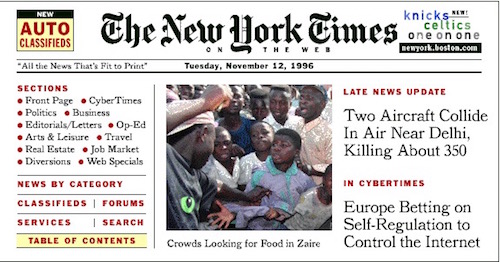
The Times reported on the event, of course: “The electronic newspaper (address: http:/www.nytimes.com) is part of a strategy to extend the readership of The Times and to create opportunities for the company in the electronic media industry.” The story ran on Page D7.
(The eagle-eyed will notice that the online version of the story gets the address slightly wrong, with only one slash after the “http:” rather than two. Today’s web browsers can deal with the omission; those of 1996 couldn’t. The print version — which is where people would have been reading it, naturally — got it right.)
The Times’ had begun publishing on AOL in 1994. In 1995, the Times created The New York Times Electronic Media Company to develop the paper’s digital presence, and that fall it launched the first beta of the Times’ website.
Martin Nisenholtz was president of the Times Electronic Media Company and joined the company in 1995 to launch the website. In a 2013 interview for the Riptide project, Nisenholtz — who came to the Times from an advertising and interactive media background — explained how the paper approached the new website (see this video starting around 9:30 in):
My thinking was, The New York Times should maybe approach the web, in some ways, the way Yahoo did. Yahoo was a kind of directory, and I thought, “Well, jeez, the Times could do, in essence, what Yahoo was doing. It could find the best stuff for people.” The journalism of The Times, probably, was not — at that point, in any event — very interesting on a PC. It was just very, very clunky. But I realized very quickly that was just not going to happen.
What The Times wanted, for good reason in some ways, was to publish the journalism of The New York Times on the web. In fact, that’s what I think, probably, 99 percent of the people who would use The New York Times on the web would expect from it.
Now, of all the things, of all the decisions that have been made, I think that one is the most seminal. The idea to publish what was, in essence, the newspaper instead of going in a different direction at the outset.
I think that, certainly, publishing the newspaper on the web is what was expected. It’s what the consumer expected. It’s what was logical. It was low risk, in many respects. It didn’t cost very much because we already had the content. It made a world of sense.
But, in some ways, some fundamental ways, it kept the Times from truly being a great innovator, because it didn’t allow for something startlingly new. [laughs]
At launch, the Times’ website was free for users in the United States, but the paper decided to charge readers who accessed the site from abroad. For $1.95 a pop, users could also download stories to their computers and the site also offered “a customized clipping service” that let users set up email alerts by topic.
From a business perspective, Nisenholtz said, the Times’ focus was squarely on online advertising, so the paper wanted to build as large an audience as it could on its website, and after about 18 months it decided to stop charging readers outside of the United States for access to the site.
Times publisher Arthur Sulzberger, speaking at a 1995 Nieman Foundation conference on public interest journalism in the “On-Line Era” called the paper’s digital efforts an “experiment.”We got, I want to say, about 3,600 subscribers. One of the things I like to say is we ended the experiment on Bastille Day, and that day, I believe it was in 1998, we got more registered users in about an hour than we had subscribers in the last 18 months.
The fact is that, at that time, in a general news context, given the quality of the product that we were building in a narrowband context, very crude technology, we absolutely, I think, made the right decision to build the audience because, as I think we’ll get to later, we’ll see that a lot of the economics of going pay have to do with conversion rates off of your loyal base, the people who are coming to you every day.
“We don’t know where this is going. In the end, it’s going to have to pay for itself,” Sulzberger said. “We do know that. In the end, it’s going to have to pay for itself. And there’s not a lot of ways to make money.”
Sulzberger went on to say that he expected it would take some time for the Times to figure out how to make money online, but ultimately he thought it would be feasible:
I don’t need to make money this year, and I don’t need to make money next year. And I’d like to lose a little less money the year after that…But at some point, and some point not very far down the line, we’re going to have to start seeing a financial return. And I don’t think that’s going to be as difficult as we think it is today, because I think the ethos and ethics of the web are changing.
I guess I’m betting on that, aren’t I? Am I wrong?
He wasn’t wrong, but it took the Times a while to get there.
The Times’ initial assumption was that it would be able to support its web operations by selling display and classified ads on its website. An onslaught of competition from online companies hampered the Times’ (and other newspapers’) advertising business both in print and online, upending the news industry’s business model.
Though the Times quickly abandoned its first attempt to charge for its journalism online — and had only middling success with its mid-2000s effort TimesSelect, killing it after two years — it eventually came back to the strategy for good in 2011 when it launched its metered paywall. Print advertising revenue is still critical, making up 73 percent of the Times’ total ad revenue in the third quarter last year, but the paper is looking increasingly to digital subscriptions for revenue growth.
Last year, the Times said it had signed up 1 million paying digital subscribers, and in October it said it aimed to double its digital revenue to $800 million by 2020. One of the keys to that initiative will be digital subscriptions; just today Mashable reported that the Times is experimenting with cheaper subscriptions for iPhone users. It’s also trying to reach new audiences by optimizing its reporting for different mediums, especially on mobile, while also offering higher quality advertising products. In addition, the Times is attempting to reach more subscribers internationally by adding foreign-language editions.Though the Times’ digital output has obviously grown immensely since 1996, it’s still experimenting with how it will continue to report and tell stories online — and it can all be traced back to that day 20 years ago when the Times debuted on the World Wide Web.
“At the time, nobody really could know ultimately how important this was,” Nisenholtz said in an interview in December with the Times’ corporate site. “We all had a sense that something important was happening, but at the time there were actually very few users. So it was a bet on people getting online and buying more PCs.”
This gun-shaped plunger actually makes gun sounds when you pull...

This gun-shaped plunger actually makes gun sounds when you pull the trigger. #MeanwhileInTexas http://ift.tt/1RG2i3V
Star Wars or Animal Plush Bouquets are the Perfect Geek Valentine's Day Gift
Star Wars or Animal Plush Bouquets are the Perfect Geek Valentine's Day Gift
D'aww! ♥ These are so cute and cuddly! I'm sure any geek girl or guy would love to receive one of these adorable Plush Bouquets for Valentine's Day or any other special occasion! There's many to choose from, for the Star Wars fan in your life there's the Star Wars assortment, Droids or Darth Vader & Stormtroopers and there's also kittens, unicorns, dinosaurs and puppies! :D


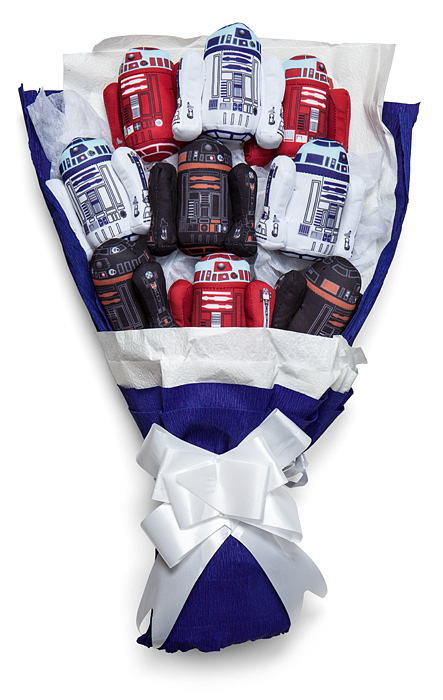

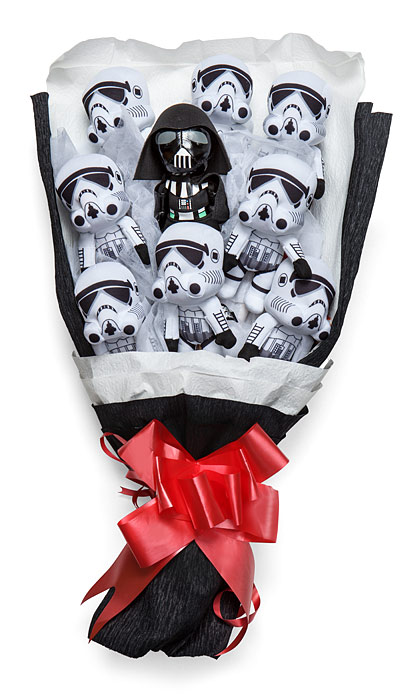

Peachy
 There are adults whom a bedroom like that would be right up their alley. , anyone?
There are adults whom a bedroom like that would be right up their alley. , anyone?See more: Peachy
Comic for 2016.01.22
Dan JonesCan't they go into a bathroom to Buzzfeed like other people?

Star Trek: TOS Family Car Decals
Star Trek: TOS Family Car Decals
WANT! Now you can show off your family's love of Star Trek with these cute Star Trek: The Original Series Family Car Decals! The set includes 32 decals total, 23 distinct characters from Star Trek: TOS. And if your family is a next generation of trekkie, there's also these Star Trek: TNG decals here! Or you can mix and match with these Star Wars decals here! :D




(Mix and match with the Star Wars decals available here!)
Star Trek: TOS Family Car Decals available here!
Follow us on:
January 22 2016
The Strange Life Of Q-Tips, The Most Bizarre Thing People Buy
Years ago, my mother complained about a terrible earache. The pain was unbearable. And it wouldn't go away — for a week, she walked around with a debilitating ringing in her head.
Eventually, she recalled to me the other day, the discomfort led her to a doctor, who carefully pushed an otoscope into her ear. Within seconds, he pulled it out and looked her in the face.
"Have you been putting Q-tips in your ears?" he asked with a disapproving tone.
Like so many others, my mother had been using Q-tips to clean her ears. But in doing so she was also messing with a natural process. Her ear was hurting because she had an ear infection, and there's a decent chance her routinely using Q-tips had helped cause it.
"Promise me something," the doctor told her. "Promise me you'll never put another Q-tip inside of your ear."
Q-tips are one of the most perplexing things for sale in America. Plenty of consumer products are widely used in ways other than their core function — books for leveling tables, newspapers for keeping fires aflame, seltzer for removing stains, coffee tables for resting legs — but these cotton swabs are distinct. Q-tips are one of the only major consumer products, if not the only, whose main purpose is precisely the one the manufacturer explicitly warns against.
The little padded sticks have long been marketed as household staples, pitched for various kinds of beauty upkeep, arts and crafts, home-cleaning, and baby care. And, for years, they have carried an explicit caution — every box of Q-tips comes with this caveat: "Do not insert inside the ear canal." But everyone — especially those who look into people's ears for a living — know that many, if not most, flat out ignore the warning.
"People come in with cotton-swab-related problems all the time," said Dennis Fitzgerald, who is an otolaryngologist in Washington, D.C.. "Any ear, nose, and throat doctor in the world will tell you they see these all the time."
"People say they only use them to put makeup on, but we know what else they're using them for," he added. "They're putting them inside their ears."
No one told us not to
While Q-tips were never sold for use deep inside the ear, it took around half a century for manufacturers to explicitly warn against it.
The versatile little household staple was the brainchild of a man named Leo Gerstenzang, who thought to wrap cotton tightly around a stick after watching his wife preen their young child. She was using a toothpick with a cotton ball on the end to carefully apply various things to the baby, a clever but easily improved trick.
In 1923, Gerstenzang introduced Baby Gays, the first sanitized cotton swabs. They were similar to those sold today, save for a few key differences. They were made of wood, instead of plastic or paper; they were single-, not double-sided; they were meant to be used for baby care, rather than everything under the sun; and, most importantly, they didn't discourage putting them inside of ears.
"Every mother will be glad to know about Q-tips Baby Gays (the Q stands for "quality"), sanitary boric tipped swabs for the eyes, nostrils, ears, gums, and many other uses," a 1927 print advertisement read.
In the years that followed, many things changed, including the name, which was shortened to just Q-tips; the material, which shifted to paper; and the marketing, which broadened to include all sorts of other household uses. But one thing didn't: the absence of a warning.
It wasn't until sometime in the 1970s that boxes began to caution against sticking the things inside of ears. A vintage box from shortly after the new labeling practices (available for purchase on Ebay) says "for adult ear care" on the front.
But the box also sports directions on the back advising against using them inside of the ear canal.
Today, the warnings are even more explicit. They say, rather unambiguously, "Do not insert swab into ear canal."
What exactly prompted the change is unclear. There is no record of a publicized case around that time in which a Q-tip was blamed for damage to someone's ears. Nor does Unilever, which now owns the brand, attribute the shift to anything in particular.
"The brand has been around nearly 100 years so there’s been a few iterations in packaging," said Carolyn Stanton, a company spokeswoman. "The earlier boxes were intended for baby care so it wasn’t relevant at the time."
But the impetus for the switch must have come, at least in part, from an understanding that many people were misusing the cotton swabs. The earliest boxes were intended for baby care, but for decades the product was also pitched for many other tasks — including as an ear-cleaning tool for adults.
"Dad has found the 'ideal' blotter for water in the ear," an ad from the mid-1900s read.
Despite the cautionary label that was added to packaging, Q-tips were still — as they had been for decades — marketed as a tool for ear cleaning.
In 1980, a commercial for the brand featured Betty White, who encouraged people to use them on eyebrows, lips, and ears. "This is a Q-tips cotton swab," she said. "They call it safe swab."
A separate TV spot, cushioned with uplifting music and cute animation, shows a child using the cotton swabs on a dog's ear, and then a mother using them on a baby's ear.
In 1990, a piece published in The Washington Post joked that telling people to use the swabs on "the outer surfaces of the ear without entering the ear canal," as Q-tips packages do, was akin to asking smokers to dangle cigarettes from their lips without ever lighting them.
The twisted pleasure of cleaning your ears
The cigarette analogy is an apt one. We continue to twist Q-tips in our ears thanks to a simple truth: It feels great. Our ears are filled with sensitive nerve endings, which send signals to various other parts of our bodies. Tickling their insides triggers all sorts of visceral pleasure.
But there's more. Using Q-tips leads to what dermatologists refer to as the itch-scratch cycle, a self-perpetuating addiction of sorts. The more you use them, the more your ears itch; and the more your ears itch, the more you use them.
Fitzgerald, the otolaryngologist, said he appreciates the cigarette analogy but insists there's nothing funny about the temptation to stick cotton swabs into your ears. At the heart of the problem is a fundamental misunderstanding Fitzgerald believes manufacturers have helped propagate, even if unintentionally, by talking in advertisements about their use in ear cleaning.
"People have been led to think that it's normal to clean their ears — they think that ear wax is dirty, that it's gross or unnecessary," he said. "But that's not true at all."
Fitzgerald likens ear wax to tears, which help lubricate and protect our eyeballs. Wax, he says, does something similar for the ear canal, where the skin is thin and fragile and highly susceptible to infection.
"Your body produces it [ear wax] to protect the ear canal," Fitzgerald said. "What you're taking out is supposed to be in there. There's a natural migration that carries the wax out when left alone."
Even if our ears were meant to be cleaned, the truth is that Q-tips would still be a terrible thing to use, he says. The shape, size, and texture of cotton swabs is such that inserting them into your ears tends to push wax inward, toward your ear drum, rather than woo it out.
"Pushing wax in, as Q-tips tend to do, can induce hearing loss," said Fitzgerald. "They can also be inserted too deeply and rupture the ear drum or damage the small middle ear bones, both of which happen more than you would think."
For this reason, the American Academy of Otolaryngology listed cotton swabs as an "inappropriate or harmful intervention," even when earwax needs to be forcibly removed from the ear, in its 2008 guidelines.
An earache for patients, a headache for doctors
It's surprisingly hard to figure out how often people hurt themselves by putting Q-tips in their ears each year.
The Consumer Product Safety Commission tracks injuries associated with all sorts of household goods, including cotton balls. But it doesn't, for reasons unclear, track those associated with cotton swabs.
The screenshot below is from the new CPSC report (the numbers are item codes, not injury tolls). Next to cotton-tipped swabs, it says "do not report."
Swabs, a CPSC representative explained by email, "are not under CPSC’s jurisdiction as they are considered a medical device." Medical devices, she said, are overseen by the Food and Drug Administration.
On the FDA's website, it does say that swabs are classified as medical devices because they're "used to apply medications to, or to take specimens from, a patient." But it also says the same for cotton balls.
Neither the FDA nor the CPSC could explain why the commission was tracking injuries associated with cotton balls, but not cotton swabs. The CPSC suggested reaching out to the FDA. The FDA suggested reaching out to the CPSC. In the end, no one had an answer.
But the discrepancy has a significant effect: It means it's much harder to quantify the number of Q-tips-related injuries that occur each year in the United States. The FDA houses complaints on its website, but doesn't add them up.
"It would be very tedious to figure out how many injuries associated with cotton swabs were reported each year," said Deborah Kotz, an FDA spokeswoman.
Kotz suggested searching the agency's database for reports, which turned up several instances in which people had incurred injuries after using cotton swabs inside of their ears and bothered to file a report. In one case, a patient filed a complaint after cleaning their ears "for the first time as recommended by a friend." In another, a consumer complained that the cotton had separated from the stem.
But doctors don't need an official database to know that cotton swabs are a problem.
"Everyone puts them inside their ears, but no one should," said Fitzgerald, the otolaryngologist. "They're one of most common contributors to ear problems."
A 2011 study by Henry Ford Hospital found a direct association between the use of cotton swabs inside ears and ruptured ear drums. It also noted that "more than half of patients seen in otolaryngology (ear, nose and throat) clinics, regardless of their primary complaint, admit to using cotton swabs to clean their ears."
Fitzgerald, who said he can immediately tell when someone has been using Q-tips, lamented that the warnings aren't working.
"I can't tell you the number of times I've told someone to never put them in their ears and then been told that they had no idea," he said.
Q-tips are here to stay
Today, there is not a single ear on the official Q-tips website. There's a woman using the cotton swabs to apply makeup to her lips, another using them for nail polish, a dog, a baby, and a sparkling clean living room, among other things.
The variety reflects Q-tips' business strategy, which increasingly has been driven by a desire to broaden the product's appeal.
"The marketing expanded to 'all purpose' use in the late 1990s and 2000s," said Svetlana Uduslivaia, who is the head of tissue and hygiene at Euromonitor, a market research firm. The firm estimates $208.4 million in Q-tips sales in the U.S. in 2014, up from $189.3 million in 2005.
"People may use it [Q-tips] for ear cleaning, but we instruct against it," said Stanton of Unilever.
The problem, of course, is that people do. Barbara Kahn, who teaches marketing at the Wharton School of Business, said it's particularly difficult to change how people perceive Q-tips because they are such a historic brand.
"They're trying to change how people think of the product, to build a brand that's separate from the original and inappropriate use, but that's really hard when everyone knows a product and thinks about it in a certain way," she said. "If people are telling others to use Q-tips for their ears, if that message is coming through virally through videos or some other media, or just moving from customer to customer, that's a very powerful thing they can't control."
She added: "There's really no way to stop it short of taking the product off the market, which they're obviously not going to do."
Fitzgerald agrees.
"If it were up to me, they wouldn't be on the market," he said. "When I treat people with recurring ear problems, I make them promise they're going to throw away their Q-tips and never buy them again. The ones who keep coming back with infections are the ones who don't listen."
Mimicker Alarm from Microsoft Garage is a playful way to wake up
Dan JonesAn MIT-licensed Android app from Microsoft?
Next thing we'll hear is that Windows 11 is going to be a Linux distro.
Playful and fun-loving aren’t the terms that I would typically associate with Microsoft, but the Mimicker Alarm app comes from Microsoft Garage — they produce projects in small teams distributed throughout Microsoft, like Google Labs does inside of Google — which is perhaps where they keep all the zanier folk.
So what exactly is the Mimicker Alarm app? You will no doubt be shocked to hear that it is an app designed to wake you up in the morning. Setting up the alarm looks very much like any other alarm app, and it adheres well to Material Design principles for those that value that kind of thing. Where it departs from the run of the mill alarm app is when that alarm goes off. You can snooze for five minutes, but as soon as you dismiss the alarm you are given 30 seconds to complete a challenge.
In order to make sure that you not only wake up, but actually stay awake, the Mimicker Alarm app forces you to play a game with it in order to shut it off. “Game” is perhaps a strong term for what the app asks you to do; tasks can vary from making a specific expression at your camera, taking a picture of something that matches a specific color or repeating back a tongue twister. The point is that they require you to focus on a task and likely long enough that you will be forced out of your restful state and be ready to face the day.
The game relies on Microsoft’s Project Oxford, which you may have seen previously powering things like How-Old.net, which attempted to identify the users age from a photo, or the TwinsOrNot.net site that logically enough tried to compare two photos and identify whether they are of twins (or the same person).
The main intent of this app, as with previous projects leveraging Project Oxford, is to show off the capabilities of the APIs. It is entirely open source, with the code available on GitHub. This is a useful and clever app that you can download for free if you are looking to change up your morning wake up routine.
What I Learned From Hacking My Sleep Schedule And Going 'Polyphasic'
By 5:15 AM, I was bored again.
It was winter 2011, and I’d just managed—after a month without coffee, alcohol or cigarettes (more or less)—to prise my internal sleep clock into two chunks. No longer would I fall into bed around one and crawl out again in time for three quick coffees and a glazed afternoon in the lecture theatre. Instead, after fastidious internet research, I had decided I would switch to what the online sleep community refers to as a “biphasic schedule”: sleeping from midnight to 4:30 AM, then napping from noon ‘til half one.
I would feel great, the internet promised. Perpetually refreshed and productive, with the added benefit of an extra three hours to commit to worthy, studious pursuits. I’d probably write a novel, or compose an epic poem, just to fill the time.
It was that morning I realised I’d hoodwinked myself. Cheating my sleep sounded like such an obviously useful piece of lifehacker-y that I hadn’t really given any thought to what I’d use my extra time for beyond nebulous “worthy stuff.” And so I sat alone in a silent student flat, staring glumly out at a pitch black November, bored and already worrying how I could get back from uni in time for my compulsory 90-minute kip at midday and how many cigarettes I could feasibly have between now and then without over-stimulating myself and throwing away all the progress I’d made so far.
But after I ditched my biphasic sleep cycle (less than a month later, after realising I’d basically become a well-rested urban hermit), I kept guiltily browsing the success stories of others online. I felt like a failure. Who were these people, giving up millennia of evolved behaviour for extra work-time? What were they doing with it? What made them so much better at this than me?
“I always hated the idea of being asleep because I thought it was a huge waste of time.”
My niggling inferiority complex was not helped by talking to Reddit’s /r/polyphasic subscriber Juanito Taveras about his sleep schedule. Known as “Dual-Core 1,” it’s a sleep pattern made up of one three-and-a-half-hour sleep at night, another 90-minute to two-hour sleep about four hours later, and finally, for Juanito, a 20-minute nap around lunchtime. Totted up, that gives Juanito a total sleep time of between five and five-and-a-half hours per day—a substantial saving on the eight hours he used to sleep “monophasically.”
But really, the main difference between our two experiences is that Juanito actually found something to do with all the extra time, other than look out the window and grumble.
“I’ve always been a very efficient person,” he told me, with more modesty than comes across in print. “I always loved reading a lot, I play a lot of instruments, I’m a programmer, I make movies. I always hated the idea of being asleep because I thought it was a huge waste of time.”
“[Before polyphasic sleep], everybody knew me as the guy who was always sleep-deprived,” he continued. “I was always staying up late watching things or building things. I would fall asleep in class; my teachers would slam their books on my desk to wake me up. So one day I came across this YouTube video that talked about this thing called polyphasic sleep... I was like, ‘I need to try this and see if it works!’”
Juanito didn’t mess about, either. Now a 20-year-old student, he started experimenting with more extreme patterns of sleeping when he was still in high school, including the infamous “Uberman Schedule”—the grail of timesaving sleep evangelists that demands adherents nap for just 20 minutes, six times a day. Depending on your constitution, the schedule will (or at least claims it will) leave you with a whopping 22 hours of free time per day. Or a shambling, zombified wreck.
“We ended up sleeping two hours per day. It was great having all that time to read, to study, to watch movies.”
Happily for Juanito, his time with Uberman was, as he tells it, an explosion of energised productivity.
“Some of my experiences were quite amazing,” said Juanito of the schedule, which he tested for three weeks with help from an “adaptation buddy”—sort of like an alcoholic’s sponsor, only for off-schedule napping. “We ended up sleeping two hours per day. It was great having all that time to read, to study, to watch movies. It was a lot of fun.”
While Juanito went polyphasic to give himself more time for creative pursuits, Brandon Parker’s needs were more pressing, and his sleep habits more pragmatic.
“I used to have sleep problems and periods of insomnia,” Brandon, a 19-year-old /r/polyphasic member, told me. “I also have a job right now, and I’m also studying. I could [do both with regular sleep], but it would be a lot harder… I found a polyphasic site and started reading posts on there, and thought, ‘I have to try it.’”
Brandon’s sleep cycle, which he’s been using for a year, is known as “Everyman-4,” in which he sleeps for a four-and-a-half hour stretch at night, with two twenty minute naps during the day. Since making the switch, he’s fixed his sleeping problems (“It used to take me an hour to go to bed; now I can fall asleep in five minutes,”) but also found extra time for hobbies like drawing, guitar, and video games.
“I’m way more productive with it,” he said. “It just feels more natural to me… Even if I weren’t studying or didn’t have a job, I’d still stick with the schedule.”
“If you want to stay up or go out and party, you have to limit that. That’s the big downside.”
The promises of polyphasic sleeping are seductive. Stories like Brandon’s and Juanito’s are typical of communities like /r/polyphasic—message boards filled with perpetually energetic and enthusiastic converts to the restless church. But for all the earnest stories of polyphasic sleeping as a lifestyle panacea, I couldn’t find much discussion of the compromises. I thought back to all the times I had to break off plans or stay in because my rigid new sleep pattern was too brittle to fiddle with, and couldn’t help but look at the glowing reports a bit like the unsolicited pharmaceutical offers in my spam folder. If polyphasic sleep works as well as they claim, why isn’t everyone doing it? And why couldn’t I?
“It may very well be that some people can sleep a certain number of hours, wake up, and work and feel creative,” said Derk-Jan Dijk, professor of sleep and physiology and director of the Sleep Research Centre at the University of Surrey. “And then after four or five hours of work they feel somewhat tired and less creative so they take a nap, and wake up feeling better than before the nap. That could very well be. But I’m certainly not suggesting that we should all go to a polyphasic pattern.”
As Dijk explained, there’s a fundamental difference, from a scientific perspective, between sleeping in several chunks for eight hours total (he gives the examples of siesta cultures, and the habits of the writer Franz Kafka) and the sort of timesaving polyphasic sleep advocated by Juanito and Brandon. The new breed of polyphasic sleepers are effectively guinea pigs, and Dijk is inclined to be cautious.
“From a sleep regulation perspective, [sleepers like Juanito and Brandon] live under an overall higher sleep pressure,” he said. “The epidemiology suggests that short sleep durations—sleeping less than five or six hours—are associated with negative health outcomes; for example, cardiovascular disease and problems with immune function. Whether in the long-term this [kind of] sleep restriction will have negative consequences is unclear. There is certainly no data to the contrary. I would never recommend [these kinds of sleep patterns].”
Dijk’s expertise jarred with the stories I’d heard from Brandon, Juanito and others. But it also didn’t explain why they continued to succeed where I’d long since given up. The list of famous people recognised as at least part-time polyphasic sleepers is long: Kafka, as mentioned; Ellen MacArthur; Churchill… But they had, respectively, books to write, boats to sail, and beaches to fight on. Without such pressing demands on your time, surely there have to be some costs to stepping so far out of line with friends, family and the rest of the monophasic world?
“Polyphasic sleep can hurt your social life,” Juanito admitted. “It is recommended that you go to sleep early—around 10pm to 2am, [most] people want to have fun, they want to party. I don’t do that. I don’t drink much alcohol, so I can stick to my schedule. So it hurt my social life somewhat, but it allowed me to achieve high grades, play a lot of music, read a lot, improve myself, and exercise.”
“In regard to social situations, you have to make it work,” Brandon agreed. “When you’re adapting, especially, you have to be right on time with your sleep otherwise it just won’t work. Once you’ve adapted you can be a little bit more flexible, depending on the schedule. You kind of have to compromise, though: if you want to stay up or go out and party, you have to limit that. That’s the big downside.”
Suddenly, I feel much better. I realise now that my decision to abandon biphasic sleeping wasn’t a failure: it was a lifestyle choice. I didn’t write a novel or a poetry compendium, not because I couldn’t, but because I chose instead to spend my time with friends instead. Bros before prose. It’s really a good thing, this bleary life of unrestricted socialising and modest achievement I’ve selected.
Yes. A good decision.
You’ll Sleep When You’re Dead is Motherboard’s exploration of the future of sleep. Read more stories.





